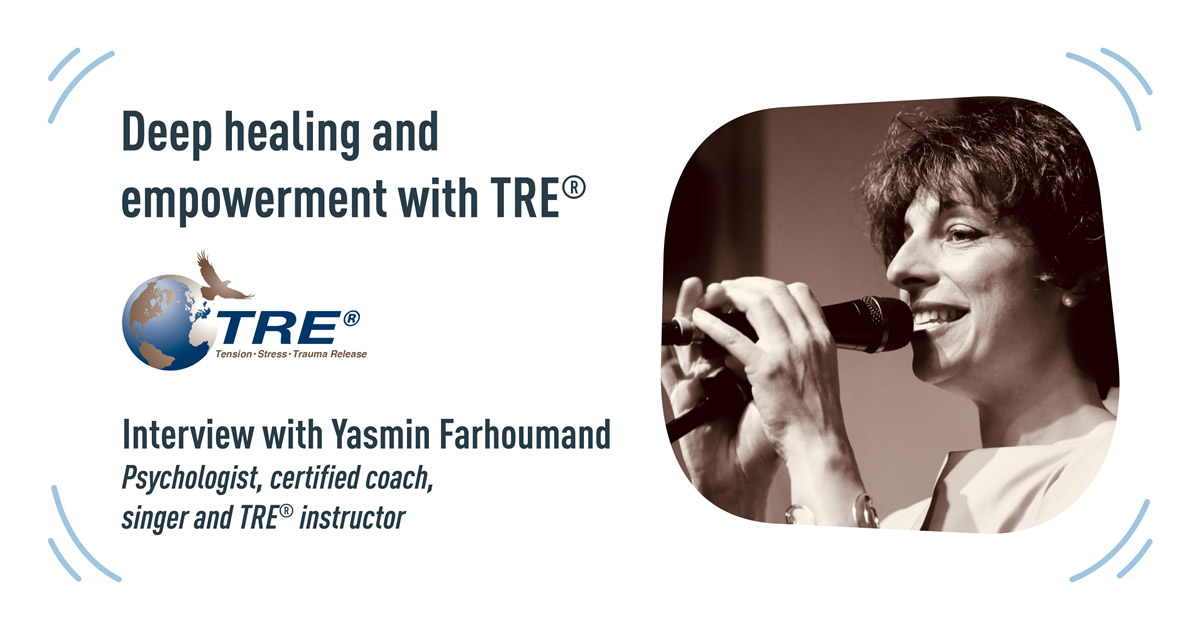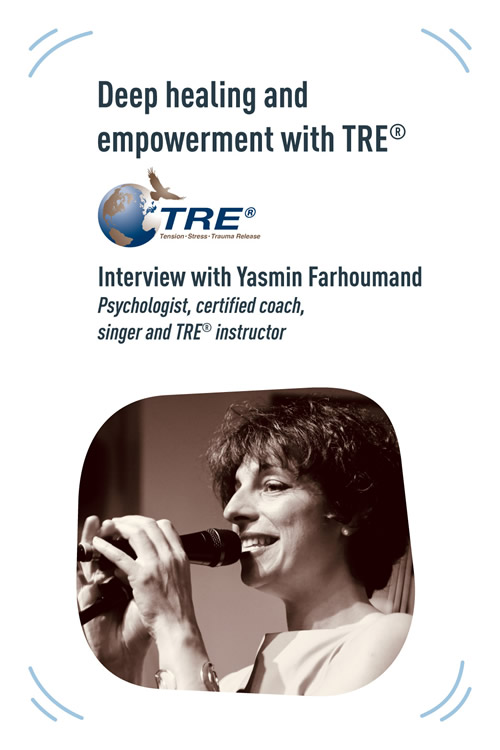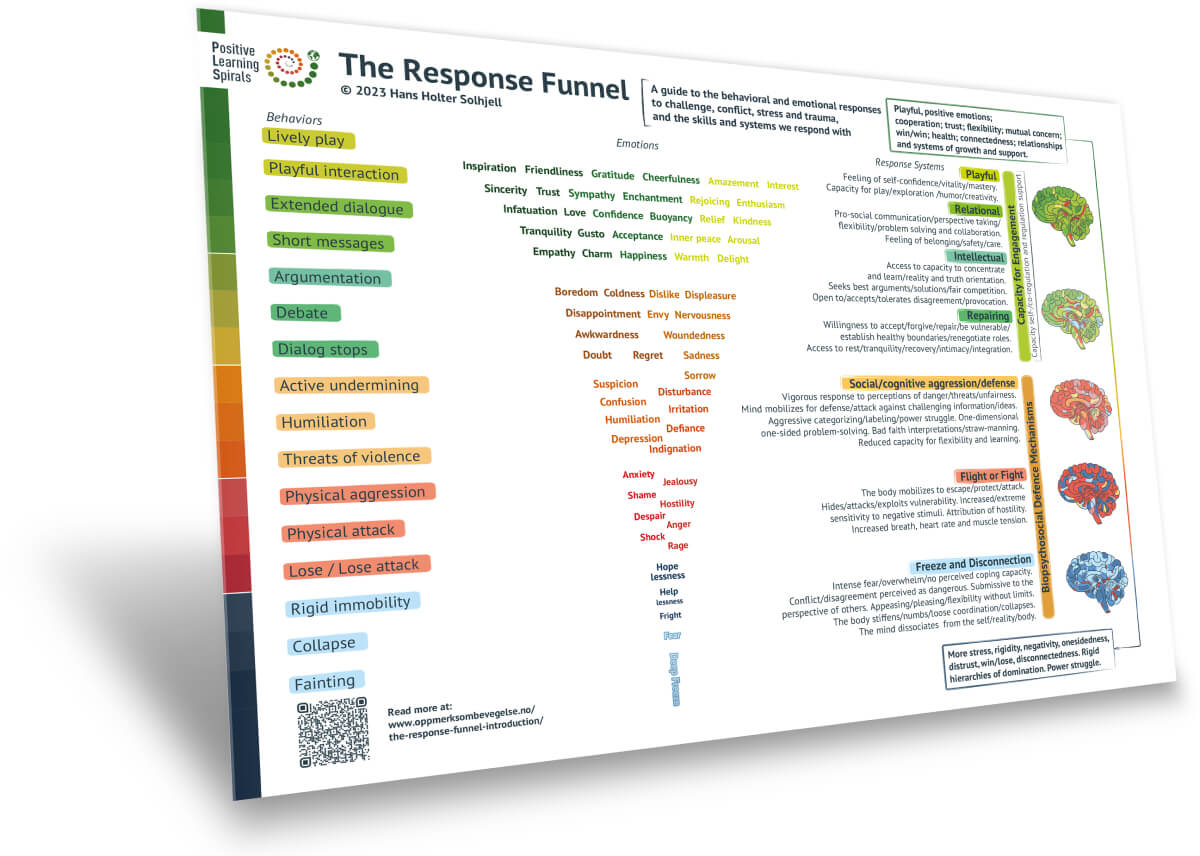

Deep healing and empowerment with TRE®
Interview with Yasmin Farhoumand
Psychologist, certified coach, singer and TRE® provider.
Interview by Hans Holter Solhjell.
Yasmin Farhoumand is a psychologist and certified TRE® instructor. She is keenly interested in body-oriented approaches and the potential for TRE® to support both practitioners and clients. In this interview, she reflects on her experience with our online TRE® instructor training program and shares some insight into how TRE® has benefited her personally and professionally.
First, thank you for allowing me to interview you and ask some questions about your TRE® experience.
Please tell us about your background and how you came to be interested in TRE®.
I have been working for over 26 years as a psychologist, accompanying adults through their professional transitions and helping them to navigate their career and life paths as harmoniously and meaningfully as possible. I studied psychology at the University of Geneva in Switzerland and specialized in organizational & educational psychology, as well as career counseling. My first job was for the HR department of the International Committee of the Red Cross for five years; I was supporting staff members who were returning from international assignments in war zones and experiencing challenges in transitioning to the Swiss job market.
Without going into details about all my other professional experiences, I want to say that I’ve had the opportunity to work with and for diverse groups of people from all walks of life, cultures, backgrounds, and ages. My jobs have involved a lot of training and facilitation in addition to individual counseling, and I love this diversity.
I would say that how I came to TRE® is more related to my path as someone who suffered from diverse symptoms and disturbing elements throughout my life, which led several times to burnout and episodes of depression. I also had a lot of physical ailments and chronic pains. I’ve always been searching for what I could to help me feel and live better and function more healthily.
I tried many complementary therapies, like acupuncture, reflexology, osteopathy, kinesiology, naturopathy, and homeopathy – you name it. And I did almost 20 years of psychotherapy, different approaches, primarily transactional analysis, but also Jungian, cognitive-behavioral, and systemic. I also experienced several methods related to breathwork, yoga, nutrition, etc.
And three years ago, although I had a very healthy lifestyle, I kept having more and more pains and chronic issues with my digestion and back, and I got pretty ill. A friend of mine sent me a video about trauma and its impact on the nervous system. In my studies as a psychologist, this is not a subject that we studied at that time in university, so it was very new for me to hear and learn about it. I realized that what I had been suffering from was probably a kind of PTSD (post-traumatic stress disorder) or complex PTSD. And the person in the video was also offering TRE®, so I started taking TRE® sessions online, which is how I got into TRE®.
You also have your singing and music – could you share something about your creative side?
In parallel to my work, I’ve been walking a path as a singer for the last 25 years. Singing and music have been essential for me to keep sane somehow. My health deteriorated when I stopped singing regularly or was not involved as much in this creative expression. So, the times in my life when I’ve been feeling best were when I was involved with a singing project. I find this very interesting.
I composed and recorded several CDs and performed in concerts on a number of occasions with three different groups. My acapella group “SKY” was the most exciting work I did as a singer because it’s only voices, so you need to focus a lot and be able to tune in to the other voices, as there are no instruments to support you. I was also always very interested in improvisation. This is why I sing a lot of jazz and now am part of a vocal improvisation group (ImproVisions) with five other singers, which is a lot of fun! So yes, I can say that music and singing have been a grounding and balancing element in my life.
Amazing. It’s fascinating to hear about the singing and the creative work. Did you feel that you had the energy to sing because you felt good, or was it the singing that made you feel good?
It was probably both, but it mainly was that it made me feel good to sing. And we know from all the neurosciences research about the connection between the breath and creative expression and what it activates when you sing. I haven’t done an in-depth study about it, but from what I have read about, it made me realize that it’s all connected and can have a healing and harmonizing effect, even at the brain and nervous system level.
It sounds like that is the case. It’s interesting to hear your personal story. Could you tell me more about how you experienced TRE® at the beginning of the training and what happened over time?
I quickly realized that TRE® was working very well for me, in the sense that I rapidly observed a significant release of physical tensions and pains to start with, followed by deep emotional release as well. This experience and the remarkable changes I noticed in myself quickly convinced me that this approach was good for me, so I practiced it intensively. This was a little more than two years ago. I started doing some TRE® every two days or sometimes even every day.
And just after a few months, my back pain – which was chronic for so many years – started reducing to a point I couldn’t believe was possible! I also started feeling a strong and positive impact on my hypervigilance and my anxiety, which had been such a prevalent feature of my functioning for so long: slowly but surely, a new sense of deep calm and inner peace started growing in me, replacing the very familiar hypervigilance, hyperactivity, and anxiety. What a relief!
I decided that I wanted to go further with this fantastic approach, and I saw that you and Robyn Dalzen were offering an online training, so I registered. I intended to go further in my practice and better understand how to use TRE®. I also felt the need to be part of a group, to be accompanied within a structured, safe, and systematic framework, and to receive coherent theoretical input, which would help me to frame and integrate my personal experience of TRE®. I found the online format to be very convenient in terms of time and organization and as it was during the COVID pandemic, so doing it online was very helpful.
During the training, some of my old trauma surfaced. Thankfully, I was in your training because it helped me to get the understanding and tools to safely work through this scary and painful episode and integrate it.
Having the supervised sessions with you and Robyn, and being able to share with the other participants in the course, helped me a lot. Reading the literature suggested in the course and putting everything together was also key. It became clear that I had been suffering all my life from developmental trauma, accentuated by specific life events, and this had all been stored in my body.
Everything started to make sense in a very concrete and embodied way, and it came as a big relief. I was finally able to let go physically of all the anger, fear, and sadness blocked for so long in my body. It was quite impressive when the emotions started releasing during my tremoring sessions. I was progressively able to connect this with what had happened in my early childhood and start a conversation with my mother about it. This process was conducive to what I would describe as my profound and sustainable healing phase.
That’s great to hear. It’s a fantastic journey you are sharing with us! Could you say a little bit more about how you experienced the training and the modules?
What I liked very much about the training was that it was very experience based. I also liked, of course, that you provided a theoretical framework. But it was always the experience and the practice at the forefront, and how you connected the experiences to the more scientific and theoretical aspects.
Your mainly “bottom-up” approach helped me to integrate the crucial aspects of tension and trauma release. To me, it was a healthy integration which I liked a lot. I also liked that the training was facilitated by the two of you, who are very complimentary in your approaches. You and Robyn have different experiences, backgrounds, and ways of framing things; this is a real asset! I don’t want to focus too much on gender, but, to me, it also was important to have both a paternal and maternal figure present. I think it created more of a sense of safety and security for me, and that’s another element I also enjoyed. I sensed a secure and safe framework, boundaries, settings and space. This is essential when you do this kind of work: to feel safe and secure. There was no judgment, and a lot of empowerment.
Thank you very much for all these kind words. I’m happy you experienced the training this way because that’s important and something we try to facilitate.
So, you talked mainly about the modules and the experience of the modules. We also had the TRE® sessions and the process of making videos and receiving feedback. Could you share a bit about how you experienced the feedback process?
Through the supervised personal sessions by Robyn and you, I was able to go much further in my exploration of how I can use TRE®. For example, I learned that I can set an intention and focus on a specific part of the body during the tremoring. This was very helpful, as well as learning to relate the physical experience to memories or dreams or symbolic, emotional elements.
It gave me the courage and the safe space to explore my body and the release with much more freedom and, I would even say audacity. It widened my perspective of what is possible. And this is very important, I believe, because when I practice on my own or accompany other people, I know there is an extensive range of possibilities to explore.
Then, there also were the sessions I had to film while giving sessions to individuals or groups to receive feedback from the TRE® supervisor. This was essential for me to know if my instructions and explanations were adequate and precise and if I was able to create a proper and safe environment for other people to experience the tremoring. Getting feedback for each video was very helpful. It helped me refocus on certain essential aspects of accompanying clients to have the TRE® experience, for example, sequencing the session more between the tremoring and the pauses. I learned how the breaks are helping the tremors to change and evolve.
I also enjoyed the journaling. At first, I resisted a lot: journaling before and after each session was a real challenge. But I’ve been recently reading over the summaries I did of my journaling, and it’s fascinating to see how my own experience was evolving.
So, I think the fact that there is a comprehensive approach to the training, with all these practical elements, is excellent. Especially because you have to work on yourself a lot. Thanks to all of these elements integrated into the training, I feel secure and empowered to handle unexpected situations with clients and support their processes.
It’s great to hear how you experienced it. It’s been some time since you did the training, so could you say how you have experienced TRE® after completing it?
I graduated about a year ago and received my certification as a TRE® provider. Since then, I’ve regularly given sessions to many individuals and groups in diverse settings. I enjoy being in a constant learning mode, asking for feedback from my clients and friends to improve my practice and understanding of how TRE® works. Continuing my own practice is essential, both alone and doing sessions with a provider or in a group setting. It has become clear to me that being a good TRE® provider/instructor requires regular practice and openness to feedback and new experiences.
A private clinic based in Switzerland contacted me recently as they were looking for a bilingual TRE® provider/instructor. They were very interested in the fact that I’m also a psychologist, as they provide care for patients with different kinds of psychological/emotional disorders. I started working for them occasionally, along with a large panel of other medical and complementary therapists they employ, and this is a great way to promote TRE®. I also plan to develop more TRE® for youth and mothers with their children (from age 8) in the context of community building in my new neighborhood.
It is very inspirational that your work with TRE® is included in the clinic. In Switzerland, is TRE® well-known?
Not yet. Maybe more in the German part of Switzerland, but I live in the French part, and in Geneva, we are only a few accredited instructors. I feel like I’m doing some pioneering work here. When I talk about TRE®, people are often very interested – especially those in somatic work, bodywork, and even psychology. I have many friends who are psychotherapists, and they are very interested in this approach, so I see some excellent possibilities for future collaborations.
But we still are at the beginning of the process, and one thing I learned for sure is to move forward slowly and surely ! I am convinced that TRE® has a great potential to become more widely known and used, but we also need more research to support the practical experiences with scientific legitimacy and foundations.
Thank you very much, Yasmin, for sharing your story and experience with TRE® and the Certification training.
It’s been a pleasure talking to you, and I look forward to future collaborations!

Download The Response Funnel model here!
The Response Funnel is a new and innovative model in the field of trauma, conflict resolution, relationships, and self-development.
To receive information about The Response Funnel please register for our newsletter. You will then receive a free copy of The Response Funnel.
